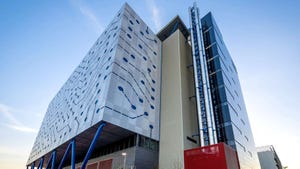How to Reduce the Environmental Impact of Semiconductor ProductionHow to Reduce the Environmental Impact of Semiconductor Production
Reducing the energy consumption of semiconductor production is key for data centers to minimize their overall carbon footprint. Here’s how to make an impact.
Much has been written in recent years about semiconductor shortages and the geopolitics of chip production. Another equally salient – but less often discussed – angle on modern semiconductors involves sustainability.
Semiconductor production consumes substantial amounts of energy, and finding ways to improve the efficiency of semiconductor manufacturing is one step toward reducing the overall carbon footprint of facilities that use semiconductors, including data centers.
The Environmental Impact of Semiconductor Production
Semiconductors are small, but the environmental impact of manufacturing them is not. According to McKinsey & Company, a semiconductor plant can consume more energy than automotive factories or oil refineries.
Greenpeace projects that by 2030, the semiconductor industry will account for 237 terawatt hours (TWh) of total electricity consumption – about the same as Australia’s total electricity use in 2021.
This might not be a big deal if semiconductor fabricators sourced their energy from renewable sources, but most don’t. A 2023 report found that 95.8% of the electricity that powers semiconductor manufacturing was sourced either directly from fossil fuels or from generic electricity grids – whose energy sources can vary but which rely primarily on fossil fuels in most cases.
Semiconductor Manufacturing and Data Center Sustainability
The energy required to produce semiconductors is important for data center sustainability. Higher energy consumption in this production process increases the carbon footprint of implementing and operating a facility.
Most measurements of data center electricity consumption and efficiency (like PUE) focus only on the energy that facilities use directly. They don’t consider the energy cost or carbon impact of producing the IT equipment that resides inside facilities. However, that cost is still an important part of the overall sustainability equation.
Data center operators truly committed to sustainability should consider the electricity necessary to produce their IT components, not just operate them.
For context, it’s worth noting that the energy used to produce semiconductors is less than the amount used to operate data centers. Data centers consumed about 411 TWh of electricity as of 2023 – a figure that is likely to continue rising at least for the remainder of the decade. This means that finding ways to make data centers more energy-efficient and to source clean energy for them, is likely to have a larger impact on the overall sustainability of data centers than reducing the energy costs of chip fabrication.
But the environmental impact of semiconductor production is by no means negligible, and moving this needle in a positive direction could be a major step toward improving data center sustainability – especially for businesses that have already invested in other types of sustainability optimizations for their facilities.
Data center operators can advocate for semiconductor manufacturers to adopt more energy-efficient production methods.
How to Reduce the Environmental Impact of Semiconductors in Data Centers
How can data center operators make semiconductor manufacturing a less egregious factor in the overall carbon impact of their facilities?
Part of the answer is not directly in their hands. It involves convincing semiconductor manufacturers themselves to invest in techniques that would reduce the energy requirements of the production process. This entails, in part, optimizing the production process itself through optimizations that reduce the energy requirements of operations like chip diffusion and etching.
At the same time, manufacturers could make their facilities more energy-efficient by following the same playbook that has served the data center industry, like making improvements to HVAC and water systems.
Data center operators can't force chip producers to make changes like these, of course. But they can work with hardware vendors that prioritize semiconductors produced in an energy-efficient way.
Meanwhile, data center owners can take some steps of their own, like not prematurely tossing out IT equipment or recycling it when they no longer need it. These practices keep chips in use longer, delivering a better “energy ROI” on the electricity expended during semiconductor production.
Investing in highly efficient cooling systems, like direct-to-chip cooling, inside data centers could also help extend semiconductor lifetimes by protecting them from overheating.
These are small steps, to be sure. Responsibility for taking the biggest leaps toward more environmentally friendly semiconductor production lies with the chip manufacturers – who, in many ways, are in a similar position to data center operators ten or fifteen years ago, when sustainability was just beginning to become a focus of the data center industry.
The good news for semiconductor producers is that a variety of energy-saving techniques have now become widespread in the data center industry, and there’s no reason similar solutions can't apply to semiconductor fabricators.
About the Author
You May Also Like









